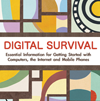- The Computer
- The Internet
- The Mobile Phone
The SIM Card
If you remove the back of your mobile phone you will find the battery, underneath which is the SIM card. SIM stands for Subscriber Identity Model and this card is where information about your network provider and your phone number is stored. By moving the SIM card you can move your phone number and stored contacts from one phone to another. This is useful if your phone is broken or damaged, because you can remove the SIM and put it in another phone. You can also put a different SIM card in your phone, and thus use a different phone number. This can be useful when you are travelling and want to use a local number (see the Travelling section).

